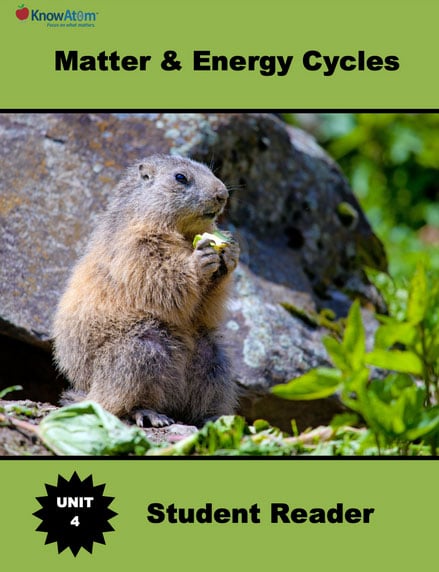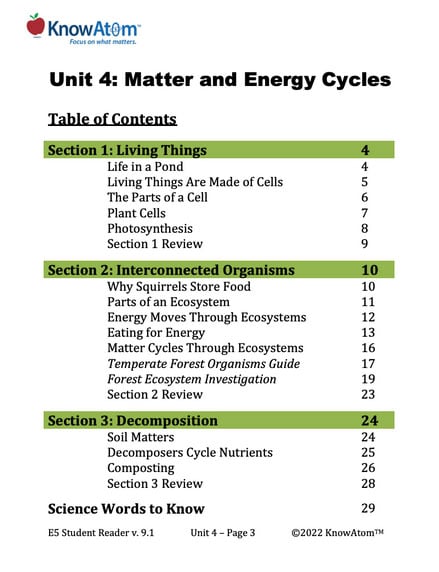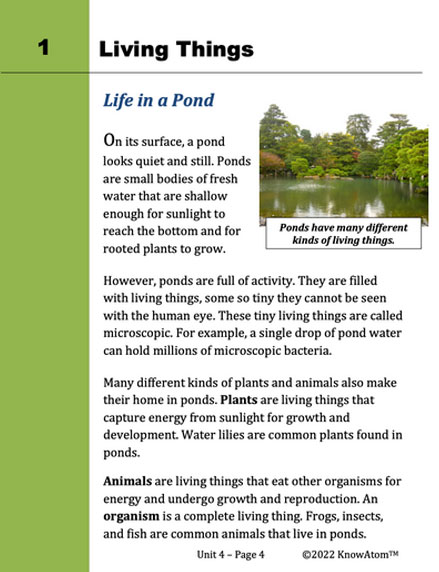In this lesson, students compare plant and animal cells, connecting the presence of specific internal structures with the way in which an organism gets energy.
In this unit, students focus on the biosphere, analyzing the science phenomena of how living things interact with one another and their environment for survival on a cellular level. This page showcases key components of this lesson.
Science background gives teachers more in-depth information about the phenomena students explore in this unit on matter and energy cycles. Below is an excerpt from the science background information on plant and animal cells.
Ponds are found all over Earth, anywhere fresh water collects in a small, still area that is shallow enough for sunlight to reach the bottom and for rooted plants to grow. Despite the stillness of the water, ponds are full of activity. They are teeming with life, including thousands of microscopic life forms that we cannot see with the human eye.
Ponds are able to support so many different kinds of life in part because of their stillness. Stagnant waters are among the richest environments for living things to thrive. Many of the organisms (complete living things) that live in a pond are microscopic and single- celled. A cell is the smallest unit of life. All living things are made up of cells, which are alive because they use energy and nutrients to carry out life functions, such as moving or finding food.
In single-celled organisms such as bacteria, the one cell is responsible for carrying out all life functions. In multi-celled organisms such as plants and animals, different cells have different tasks, and each cell works together to support the overall functioning of the organism. Plants are living things that capture energy from sunlight for growth and development. Animals are living things that eat other organisms for energy, breathe oxygen, and undergo growth and reproduction.
One essential requirement shared by all organisms, from the smallest single-celled bacteria to the complex human, is the need for energy and nutrients. Nutrients are chemicals that organisms need for the growth and maintenance of cells. Cells undergo complex processes that convert one form of energy into another. Before an organism can use the energy from food, it must be broken down into usable forms of the nutrients essential for cell life and growth.
Plant and animal cells have structures, called organelles, that must work together to keep the cell alive. Structure is the way in which parts are put together to form a whole. Each organelle has a specific function—the normal action of something or how something works. For example, the control center of plant and animal cells is the nucleus. It tells all of the other organelles what to do. This is possible because the nucleus contains the cell’s DNA, an instruction manual for how the cell should look and what it should do.
All cells are filled with a jelly-like liquid, called cytoplasm, that surrounds all of the organelles. The cell membrane surrounds the cell and selects what molecules can enter and exit the cell. The cell membrane is flexible, which is why cells can be many different shapes.
Plant and animal cells are powered by the mitochondria, which are organelles that break food down into usable energy. They combine sugar from food with oxygen from respiration to produce energy the cell can use.
Ribosomes are organelles that make proteins. The storage centers of the cell factory are the vacuoles, which are large sacs that store water, food, wastes, and other substances the cell cannot use or eliminate right away.
Other common organelles include the following:
In this lesson, students compare plant and animal cells, connecting the presence of specific internal structures with the way in which an organism gets energy.

Prepared hands-on materials, full year grade-specific curriculum, and personalized live professional development designed to support mastery of current state science standards.
Animal : a living thing that eats other organisms for energy, breathes oxygen, and undergoes growth and reproduction
Cell : the smallest unit of life
Function : the normal action of something or how something works
Nutrients : chemicals that organisms need for the growth and maintenance of cells
Organic : anything that is living or was once living (e.g., fallen leaves and animal remains)
Organism : a complete living thing
Plant : a living thing that captures energy from sunlight for growth and development
Structure : the way in which parts are put together to form a whole
Life in a Pond
On its surface, a pond looks quiet and still. Ponds are small bodies of freshwater that are shallow enough for sunlight to reach the bottom and for rooted plants to grow.
However, ponds are full of activity. They are filled with living things, some so tiny they cannot be seen with the human eye. These tiny living things are called microscopic. For example, a single drop of pond water can hold millions of microscopic bacteria.
Many different kinds of plants and animals also make their home in ponds. Plants are living things that capture energy from sunlight for growth and development. Water lilies are common plants found in ponds.
Animals are living things that eat other organisms for energy and undergo growth and reproduction. An organism is a complete living thing. Frogs, insects, and fish are common animals that live in ponds.


Living Things Are Made of Cells
All organisms, from the microscopic bacteria to the croaking frog, have something in common. They are all made of cells. A cell is the smallest unit of life. Cells are made up of molecules, which are two or more atoms joined together. Living things take in new molecules from air, food, and liquids. These molecules get into the cells and help them function. Some living things, such as bacteria, are made up of just one cell. These organisms are called single-celled organisms.
Other organisms are made up of many cells. These organisms are multi-celled organisms. Plants and animals are both kinds of multi-celled organisms.
Cells are alive because they use energy to carry out life functions. Life functions include growing, developing, and getting energy from food. Energy is required because it powers all of these actions. Plant and animal cells have different structures that help them carry out their life functions. A structure is the way in which parts are put together to form a whole.
The internal structures of a plant or animal cell are called organelles. Each organelle has a specific function. Function is the normal action of something or how something works.
The Parts of a Cell
All cells are filled with a jelly-like liquid. This liquid is called cytoplasm, and it surrounds all of the organelles. The cell membrane surrounds the cell and selects what molecules can enter and exit the cell. The cell membrane is flexible. This is why cells can be many different shapes.
The control center of plant and animal cells is the nucleus. It tells all of the other organelles what to do. This is possible because the nucleus contains the cell’s DNA. DNA is an instruction manual for how the cell should look and what it should do.
The workers that power the cell are the mitochondria. Mitochondria are organelles that break down food into usable energy.
The storage centers of the cell are the vacuoles. Vacuoles are large sacs that store water and food for the cell. Plant cells contain a larger central vacuole than animal cells. Ninety percent of a plant cell is taken up by the central vacuole. A plant wilts if its cells lose water in their central vacuoles.

In this lesson, students create plant and animal cell models to compare and contrast the internal structures of plants and animals. They use the cell models to observe relationships between the cell’s functions and its different structures. Students compare their plant and animal cell models with other student teams, and then use their observations to analyze the cell from a systems perspective, describing relationships among the various parts of the cell.
KnowAtom incorporates formative and summative assessments designed to make students thinking visible for deeper student-centered learning.

Standards citation: NGSS Lead States. 2013. Next Generation Science Standards: For States, By States. Washington, DC: The National Academies Press. Neither WestEd nor the lead states and partners that developed the Next Generation Science Standards were involved in the production of this product, and do not endorse it.
